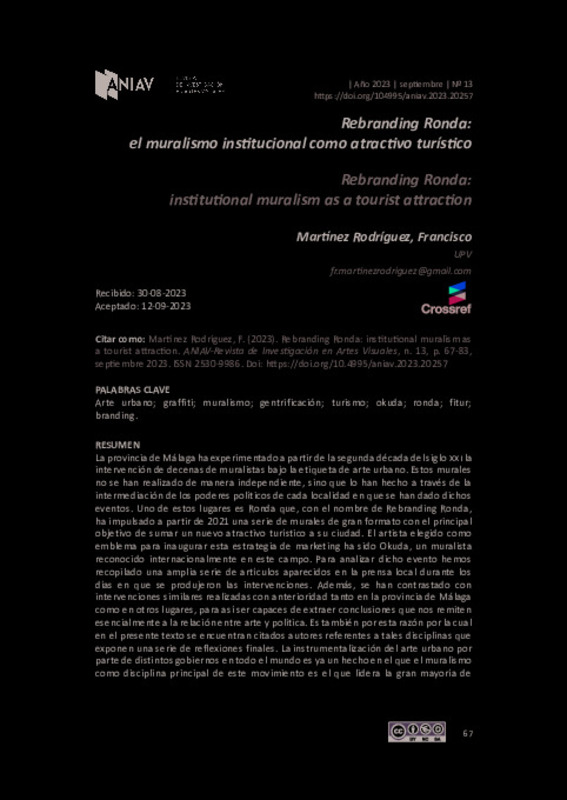|
Resumen:
|
[EN] Since the second decade of the 21st century, the province of Malaga has experienced the intervention of dozens of muralists under the label of street art. These murals have not been carried out independently, but have ...[+]
[EN] Since the second decade of the 21st century, the province of Malaga has experienced the intervention of dozens of muralists under the label of street art. These murals have not been carried out independently, but have been done through the intermediation of the political powers of each locality in which these events have taken place. One of these places is Ronda, which, under the name Rebranding Ronda, has promoted a series of large-format murals starting in 2021, with the main objective of adding a new tourist attraction to its city. The artist chosen as the emblem to inaugurate this marketing strategy has been Okuda, an internationally recognized muralist in this field. To analyze this event we have compiled a wide series of articles that appeared in the local press during the days in which the interventions took place. Furthermore, they have been contrasted with similar interventions carried out previously both in the province of Malaga and in other places, in order to be able to draw conclusions that essentially refer us to the relationship between art and politics. It is also for this reason that in this text authors referring to such disciplines are cited, which illuminate a series of final reflections. The instrumentalization of street art by different governments around the world is a more than proven fact. Muralism, as the main discipline of this movement, is the one that leads the vast majority of events. The use of muralism to attract tourists, as well as to regenerate depressed areas of cities, has become a common tool in our cities. Neoliberalism is the system that has most intensely understood the advantages that spectacular practices such as large-format muralism can bring, which become a new type of low-cost monumentality, whose signature is as or more important than the work itself. Thus, certain brand-artists become objects of desire for the rulers, sensing that with this they will provide an avant-garde incentive to their respective cities, as we understand has happened in the case we present in Ronda.
[-]
[ES] La provincia de Málaga ha experimentado a partir de la segunda década del siglo XXI la intervención de decenas de muralistas bajo la etiqueta de arte urbano. Estos murales no se han realizado de manera independiente, ...[+]
[ES] La provincia de Málaga ha experimentado a partir de la segunda década del siglo XXI la intervención de decenas de muralistas bajo la etiqueta de arte urbano. Estos murales no se han realizado de manera independiente, sino que lo han hecho a través de la intermediación de los poderes políticos de cada localidad en que se han dado dichos eventos. Uno de estos lugares es Ronda que, con el nombre de Rebranding Ronda, ha impulsado a partir de 2021 una serie de murales de gran formato, con el principal objetivo de sumar un nuevo atractivo turístico a su ciudad. El artista elegido como emblema para inaugurar esta estrategia de marketing ha sido Okuda, un muralista reconocido internacionalmente en este campo. Para analizar este evento hemos recopilado una amplia serie de artículos aparecidos en la prensa local durante los días en que se produjeron las intervenciones. Además, se han contrastado con intervenciones similares realizadas con anterioridad tanto en la provincia de Málaga, como en otros lugares, para así ser capaces de extraer conclusiones que nos remiten esencialmente a la relación entre arte y política. Es también por esta razón por la cual en este texto se encuentran citados autores referentes a tales disciplinas, los cuales alumbran una serie de reflexiones finales. La instrumentalización del arte urbano por parte de distintos gobiernos en todo el mundo es un hecho más que comprobado. El muralismo, como disciplina principal de este movimiento, es el que lidera la gran mayoría de eventos. El uso del muralismo para atraer turistas, así como para regenerar zonas deprimidas de las ciudades se ha convertido en una herramienta habitual en nuestras ciudades. Es el neoliberalismo el sistema que más intensamente ha entendido las ventajas que le pueden suponer prácticas espectaculares como el muralismo de gran formato, que pasan a ser un nuevo tipo de monumentalidad low cost, cuya firma es tan o más importante que la propia obra. Así, determinados artistas-marca pasan a convertirse en objetos de deseo para los gobernantes, intuyendo que con ello van a aportar un aliciente vanguardista a sus respectivas ciudades, tal y como entendemos que ha ocurrido en el caso que presentamos de Ronda.
[-]
|







![HTML file [HTML]](/themes/UPV/images/html.png)

